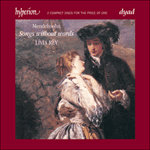Mendelssohn’s second volume of
Lieder ohne Worte, Op 30, was released in 1835, though its contents were sifted from pieces composed separately between 1830 and 1835, and then gradually selected and ordered into the opus in a distinctive arrangement of keys, alternating between major and minor, and progressing from two flat keys to four sharp keys (E flat major–B flat minor–E major–B minor–D major–F sharp minor). As was the case with his first set,
Op 19b, the composer chose examples of the solo Lied (No 1), duet (No 6), and part-song (No 3), with pianistic character pieces (Nos 2, 4 and 5). Op 30 was the first volume of
Lieder ohne Worte to bear a dedication, to Elise von Woringen, a daughter of the Düsseldorf appellate judge and supporter of the composer. The dedication helped initiate the tradition of associating Mendelssohn’s
Lieder ohne Worte with feminine qualities. Indeed, two pieces were originally written for other women. No 2, beginning in a pulsating B flat minor but turning to a joyous B flat major, celebrated the birth in 1830 of Sebastian Hensel, son of Mendelssohn’s sister Fanny, while No 6 was a gift for Henriette Voigt, a Leipzig pianist and salonnière, of whom Robert Schumann wrote that she never played a composition badly, nor ever uttered anything schlecht. The second of the 'Venetian Gondellieder', No 6 is an impressionistic miniature that features a haunting soprano cantilena subsequently doubled at the third, in effect transforming this solo
Lied into a duet.
from notes by R Larry Todd © 2014
Le deuxième volume de
Lieder ohne Worte, op.30 de Mendelssohn parut en 1835, avec toutefois des pièces composées isolément entre 1830 et 1835, puis progressivement sélectionnées et agencées dans un arrangement spécifique de tons alternant entre majeur et mineur et passant de tonalités avec bémols à la clef à des tonalités avec dièses à la clef: mi bémol majeur, si bémol mineur, mi majeur, si mineur, ré majeur, fa dièse mineur. Comme pour son premier volume
op.19b, Mendelssohn puisa dans le lied solo (nº 1), dans le duo (nº 6) et dans le chant à plusieurs voix (nº 3) mais aussi dans des pièces caractéristiques pour piano (nos 2, 4 et 5). L’op.30 fut le premier volume de
Lieder ohne Worte à arborer une dédicace, en l’occurrence à Elise von Woringen, fille du juge à la cour d’appel de Düsseldorf et soutien du compositeur. De là vient en partie la tradition d’attribuer des qualités féminines aux
Lieder ohne Worte mendelssohniens. De fait, deux d’entre eux furent originellement composés pour d’autres femmes. Avec le nº 2 s’ouvrant sur un battant si bémol mineur bientôt changé en un joyeux si bémol majeur, il célébra la naissance, en 1830, de Sebastian Hensel, le fils de sa sœur Fanny; le nº 6 était un cadeau à Henriette Voigt, cette pianiste et salonnière leipzigoise à propos de laquelle Robert Schumann écrivit que jamais elle ne joua mal une seule composition, pas plus qu’elle ne prononça quoi que ce fût de schlecht. Deuxième des «Gondellieder vénitiens», ce nº 6 est une miniature impressionniste qui présente au soprano une lancinante cantilena, doublée ensuite à la tierce—ce qui change le lied solo en duo.
extrait des notes rédigées par R Larry Todd © 2014
Français: Hypérion
Mendelssohns zweiter Band seiner
Lieder ohne Worte, op. 30, wurde 1835 freigegeben—er besteht aus Einzelstücken, die zwischen 1830 und 1835 komponiert und dann allmählich ausgewählt und in ein Opus mit einer charakteristischen Tonartenzusammenstellung angeordnet wurden. Sie stehen in zwei B-Tonarten und vier Kreuztonarten und alternieren zwischen Dur und Moll (Es-Dur–b-Moll–E-Dur–h-Moll–D-Dur–fis-Moll). Ebenso wie bei seinem ersten Band,
op. 19b, kombinierte Mendelssohn ein Solo-Lied (Nr. 1), ein Duett (Nr. 6) und ein mehrstimmiges Lied (Nr. 3) mit pianistischen Charakterstücken (Nr. 2, 4 und 5). Op. 30 war der erste Lieder ohne Worte-Band, der eine Widmung trägt, und zwar an Elise von Woringen, eine Tochter des Düsseldorfer Königlichen Appellations-Gerichts- und Geheimen Justizrats Otto von Woringen, der ein Förderer des Komponisten war. Diese Zueignung sorgte mit dafür, dass Mendelssohns
Lieder ohne Worte zunehmend mit femininen Eigenschaften in Verbindung gebracht wurden. Tatsächlich entstanden zwei Stücke dieses Werkbündels ursprünglich für andere Frauen: Nr. 2, das in einem pulsierenden b-Moll beginnt, sich dann allerdings einem fröhlichen B-Dur zuwendet, entstand 1830 anlässlich der Geburt von Sebastian Hensel, der Sohn von Mendelssohns Schwester Fanny, während Nr. 6 ein Geschenk an Henriette Voigt war, eine Leipziger Pianistin und Salonnière, die Robert Schumann zufolge nie eine Komposition schlecht spielte, noch jemals ein schlechtes Wort zu sagen hatte. Das zweite der „Venetianischen Gondellieder“, Nr. 6, ist eine impressionistische Miniatur mit einer eindringlichen Soprankantilene, die später in Terzdopplung erklingt, so dass dieses Solo-Lied quasi in ein Duett verwandelt wird.
aus dem Begleittext von R Larry Todd © 2014
Deutsch: Viola Scheffel


 Mendelssohn: Songs without words
Mendelssohn: Songs without words
